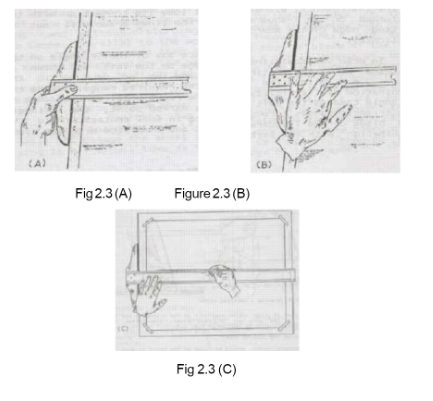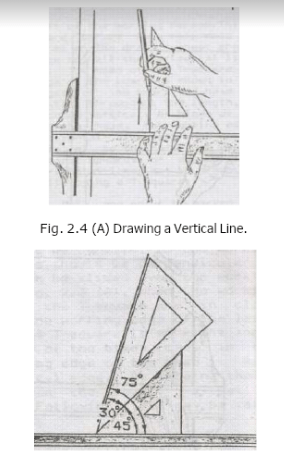
HORIZONTAL AND VERTICAL LINES ON THE BOARD
For right-handers, board should always be placed in such a position so that its working
edge is on the left of the working person. This working edge of the drawing board serves as a reference vertical line. All vertical lines on the drawing sheet should be parallel to the working edge and all the horizontal lines should be perpendicular to it. The head of the T-square can be slided over the working edge of the board as shown in Fig. 2.3 (A). When the working edges of the board and head of the T-square are in close contact throughout the length, the working edge of the later becomes vertical. As blade of the T-square is at right angle to the head, the working edge of the blade comes in the horizontal direction when working edge of the head is made parallel to the reference vertical edge. By sliding the T-square upwards or downwards on the board, a set of horizontal lines may be drawn. Following steps may be taken while using a T-square:
i) Only one point is marked on any vertical line on the sheet from where horizontal line is to be drawn. It is not a good practice to mark points at the two ends which are later on joined with any straight edge.
ii) While using a T-square, working edge of the board and head of T-square must be in
close contact throughout the contact-length. To draw a horizontal line, hold the head of T-
square with the left hand, as shown in Fig. 2.3 (A), and apply a slight but uniform lateral
pressure over the T-sqaure of the board. Slide the left hand until the working edge of blade
just passes through the already marked point. Chang your hold sothat fingers remain on
the T-square and the thumb is placed on the board, making sure that the position of the
T-square is not changed, Fig. 2.3 (B). Draw horizontal line as shown.in Fig. 2.3 (C) with
the right hand.

iii) While sliding the T-square, the blade should be allowed to move freely. If it is
touching with the right hand, note or the instruments, either the angle of the T-
square will be disturbed or the T-square will lose its connection with the working
edge of the board and the lines drawn will not be horizontal.
To draw vertical line, place any of the triangle on the T-square with the vertical edge on
the left as shown in Fig. 2.4. Slide the T-square up or down until the combination is
vertically in the required range. Slide the triangle towards the left or the right until
working edge 04 the triangle passes through the marked point, the triangle and
blade of the T-square being in full contact. Hold the combination with the left hand and
draw line with the right hand.

Fig. 2.5 (B) Using a Combination of Triangles.
Lines at other angles available on the triangles may be drawn in the same way. In
some cases, combination of triangles may also be used as in Fig. 2.5.






